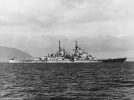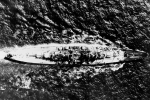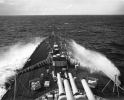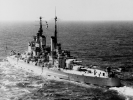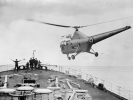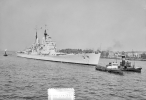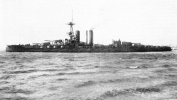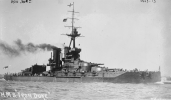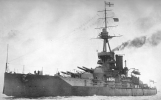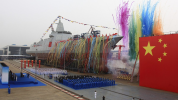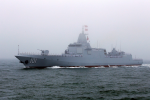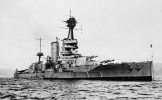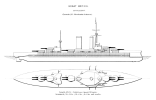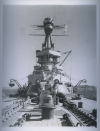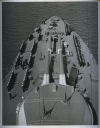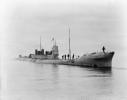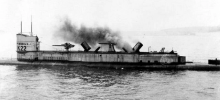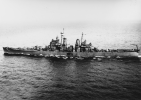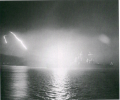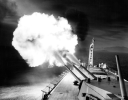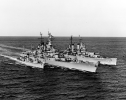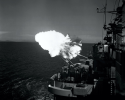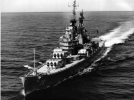The most fascinating thing about that design is the absolute lack of torpedo armor. Goes to prove you can only look so far into the future.
A few good photos of the
USS West Virginia (BB-48) showing her original exterior armor belt and then the torpedo bulges for protection added after Pearl Harbor.
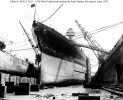
In drydock at the Pearl Harbor Navy Yard, 10 June 1942, for repair of damage suffered in the 7 December 1941 Japanese air raid. She had entered the drydock on the previous day. Note large patch on her hull amidships, fouling on her hull, and large armor belt.
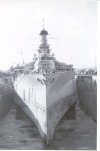
Bow view of the
West Virginia (BB-48) in drydock.
Although it is not polite to call attention to a ladies' added weight, please note her bulges added for torpedo protection.
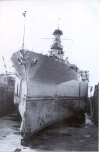
Bow view of the
West Virginia (BB-48) in drydock at Puget Sound.
And just a few more photos of the
USS West Virginia.
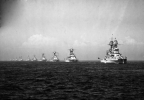
US Navy battleships in parade formation in San Diego, California, 23 August 1935.
Pennsylvania (BB-38) in the lead followed by
West Virginia (BB-48),
Colorado (BB-45),
Maryland (BB-46),
California (BB-44) and
Texas(BB-35). After the
Texas, the photo is just too "fuzzy" for an ID.
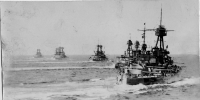 New York (BB-34)
New York (BB-34) ahead of
Pennsylvania (BB-38). The next ship ahead is a
Tennessee class (BB-43 /44) based on the slope of the turret roofs. (Uniform slope back to front - no kink like the twin 16" mounts on the
Colorado's (BB-45). Based on the relatively full appearance of the forward superstructure, I am leaning toward
California (BB-44) which had an enlarged flag bridge as Battle Force Flagship. The other three are obviously
Tennessee (BB-43) and/or
Colorado class (BB-45 / 48) but are too indistinct to ID specifically. Because of the boom cranes on the sterns, the photo was taken between 1931 and 1934.
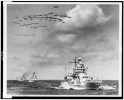
Probable front and rear photos here and below showing formations of aircraft flying over U.S. Navy battleships during exercises at sea, 1938 / 1939.
Pictured here is the
New Mexico (BB-40) in the van with other battleships of the Pacific Fleet and a carrier air group, led by the Air Group Commander in a Curtiss SBC Helldiver.
The aircraft following are:
A torpedo squadron of eighteen Douglas TBD-1s;
A bombing squadron of eighteen Northrop BT-1s;
A scouting squadron eighteen Curtiss SBCs;
A fighting squadron of eighteen Grumman F2F-1s or F3F-3s from either the
Yorktown (CV-5) or F3F-2s from the
Enterprise (CV-6), plus possibly nine additional aircraft.
The
Yorktown and
Enterprise were the only two carriers whose bombing squadrons were equipped with the Northrop BT-1.
The text for the photo reads:
"The Navy uses enormous amounts of rubber. At least seventy-five tons of rubber, enough to makes 17,000 tires, are used in the construction of each of these battleships. Tons more are needed for the naval planes that are making history over the world. Medical and communication requirements--and countless other needs of the Navy--are met."
The lead
BB looks like
Mississippi (BB-41) followed by
Maryland (BB-46) (rangefinder on Turret II). My first impression of the
Tennessee class (BB-43 /44) is the
Tennessee (BB-43), but that is not a certain ID from this photo alone. Fourth is the
Oklahoma (BB-37) (no birdbath). Aside from the
DD now in the lead, I see nothing in the head-on shot aerial that positively differs from the ID's of the first 4 BB's in the first photo. Of course, in the aft aerial shot,
BB #5 is the
California (BB-44), ID'd by the enlarged flag bridge, lending support to BB #3 in the first photo being
Tennessee.
